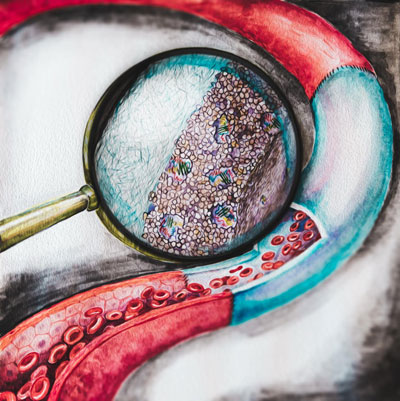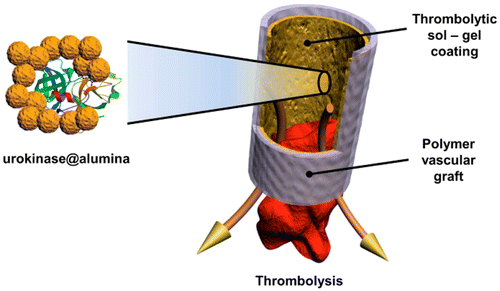
In the enlarged image inside the magnifying glass, a drug-entrapping coating attached to the inner surface of the graft can be observed. (From: ITMO University/Yulia Chapurina
Scientists from the International Laboratory of Solution Chemistry of Advanced Materials and Technologies at ITMO University have developed artificial blood vessels resistant to thrombosis. A matrix that coats the vessel inner surface can retain a clot-dissolving enzyme. The finding was published in the Journal of Medicinal Chemistry.
Cardiovascular diseases sometimes derive in the implantation of vascular grafts, artificial blood vessels that restore blood circulation. The problem with vascular grafts is their propensity to form clots. Patients usually need to take anticoagulants for life or undergo surgery.
To avoid this kind of problems, the researchers from ITMO University designed a vascular graft lined with a film of aluminum oxide nanorods blended with molecules of a thrombolytic enzyme (urokinase-type plasminogen activator). The film is a porous matrix that lets in only certain molecules. One of them is plasminogen, a natural proenzyme found in blood. When plasminogen interacts with the plasminogen activator, plasmin -a molecule that dissolves clots- forms. In this way the film, adhered to the inner part of the blood vessel, keeps a constant concentration of plasmin, avoiding clot formation.
Vladimir Vinogradov and his team tested the vascular grafts efficiency by forming artificial clots with blood plasma and thrombin. The clots where dissolved even at the stage of formation.
Recently designed vascular grafts already use drug-eluting technology, but they release drugs to the bloodstream and thus have a limited lifetime. Vinogradov’s team, on the other hand, has designed an encapsulating shell that keeps the enzymes in place for a virtually unlimited amount of time.
In the future, the same technology could be applied to other organs, keeping a given drug in the porous matrix to dissolve crystal formation or defective molecular accumulations.



